Bob Uhlig discusses “Innovation through Green Infrastructure”
Bob Uhlig, Vice President of Landscape Architecture and Urban Design at Halvorson | Tighe & Bond Studio, joined David LaPointe of Beals + Thomas to present “Innovation through Green Infrastructure” to the ACEC MA Private Sector Committee. Using a variety of case studies, the presentation focused on collaborations between engineers and landscape architects to successfully incorporate green infrastructure into their projects. Bob discussed four unique projects—Western Avenue in Cambridge, the Boston Architectural College Green Alley, Boston’s Government Center Plaza, and South Street Landing in Providence—to highlight the various ways Halvorson | Tighe & Bond Studio has collaborated with engineers, incorporating green infrastructure to achieve our clients’ sustainability goals..
Western Avenue “Complete Streets” Reconstruction, Cambridge, MA
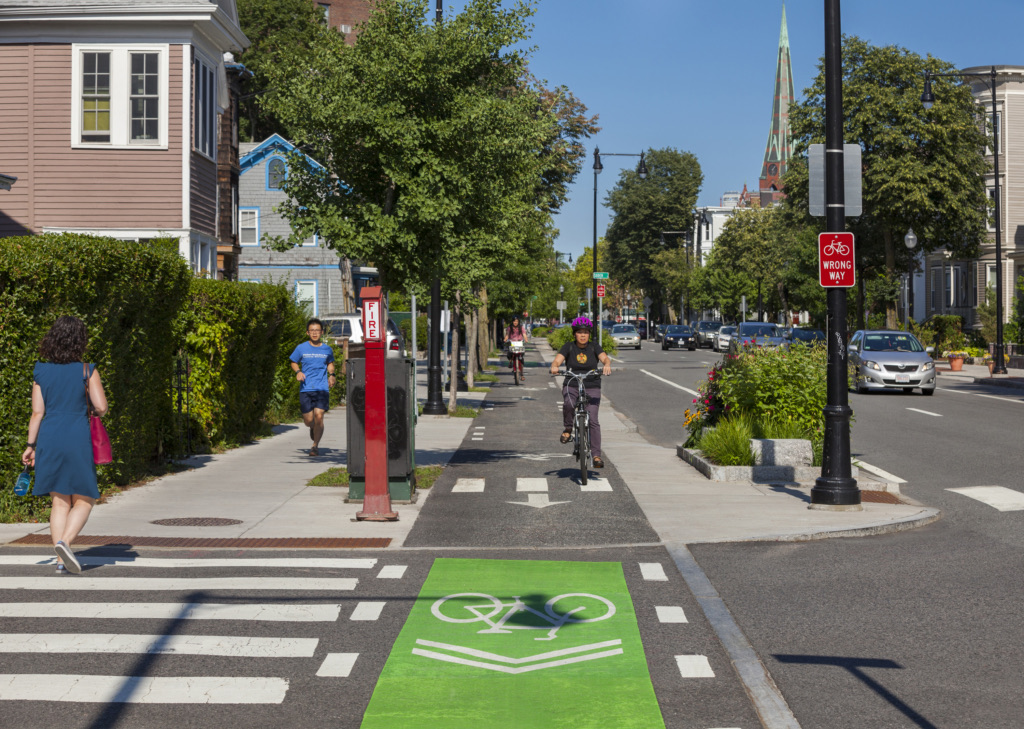
Western Avenue Complete Streets Reconstruction
Completed in 2015, the “Complete Streets” reconstruction of Western Avenue in Cambridge, MA, reinvigorates a critical connection between Central Square and the Charles River. HDR and Halvorson | Tighe & Bond Studio collaborated with the City of Cambridge to redesign this bustling corridor to create a safer, more enjoyable experience for the community.
While the primary impetus for this project was related to upgrading the aging utility infrastructure, the City and engineering/design team also seized the opportunity to rethink the functionality and character of the street itself. HDR and Halvorson worked with the City on an extensive public process to achieve their objective of supporting all users, including walkers, cyclists, bus riders, and drivers.
The new Western Avenue features generous, accessible sidewalks, safer crosswalks with shorter crossing distances, and improved urban environments. By strategically placing bus stops and increasing seating, the total number of stops was reduced, allowing buses to run more efficiently.
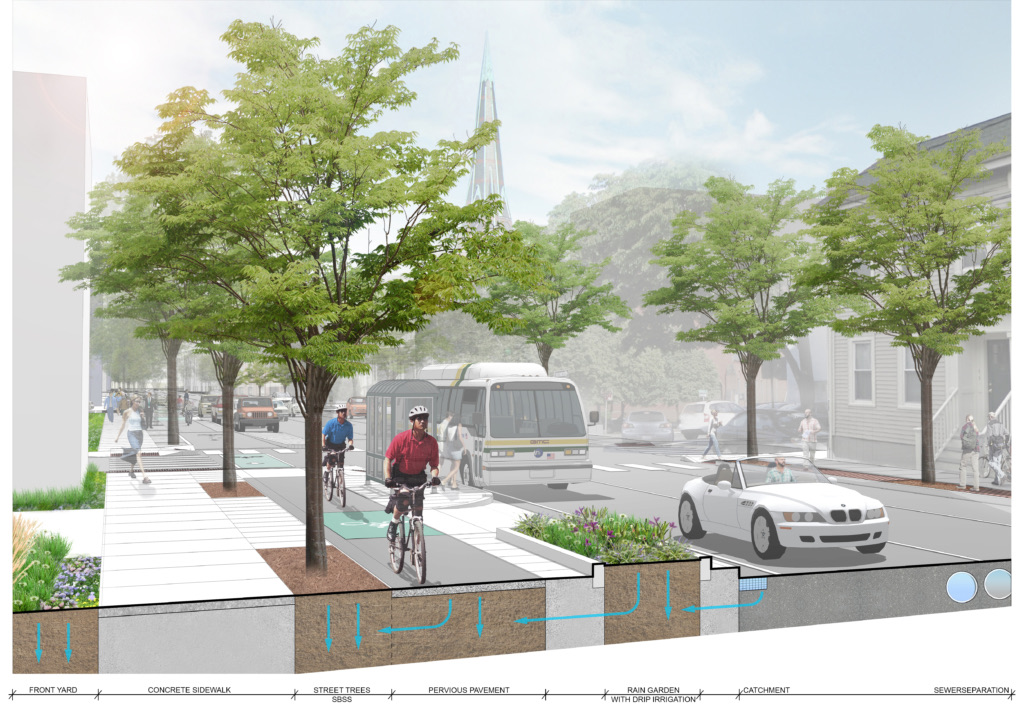
Western Avenue Section (HDR with Halvorson | Tighe & Bond Studio)
Additional safety measures, including bumpouts at signalized intersections and pedestrian crossings, raised crosswalks, and enhanced pedestrian scale lighting not only improve the pedestrian experience, but also provide cues to motorists to decrease travel speeds in a pedestrian-heavy corridor.
The team employed many innovative green stormwater management technologies—such as permeable cycle track paving with horticultural sand-based structural soil and raingardens—to serve as aesthetic amenities and remove salt and phosphorous from the system at first flush. Eighty new street trees were planted in expanded tree zones, and plantings and planting beds increased in number and overall area to reduce impervious surfaces and provide seasonal character along the corridor.
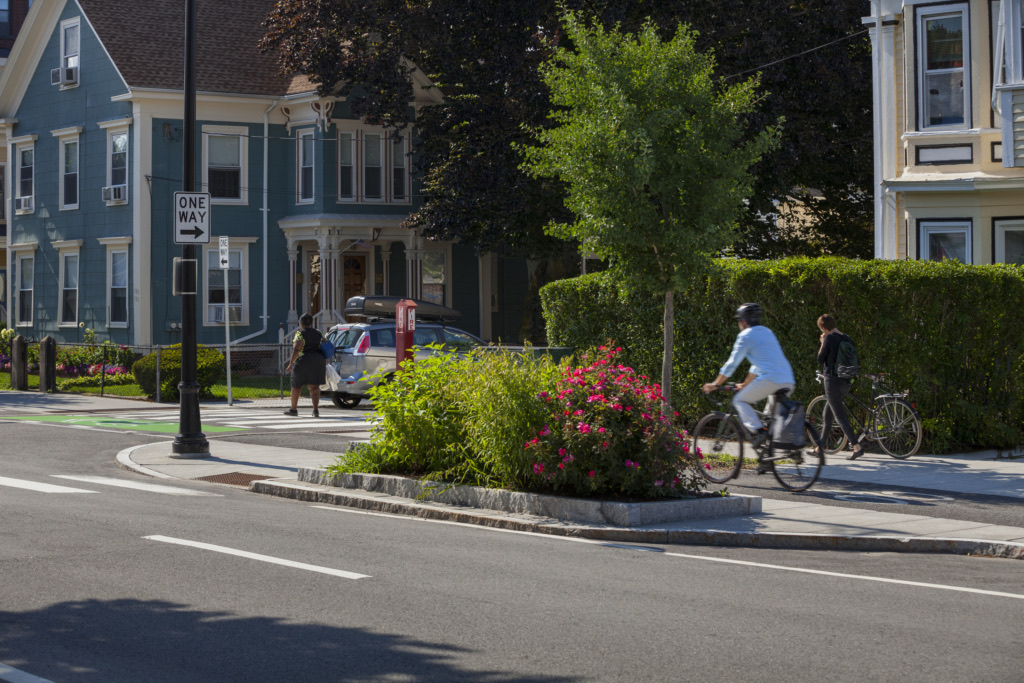
Halvorson and HDR are currently collaborating with the City of Cambridge on the “Complete Streets” reconstruction of River Street, which runs the opposite direction from the Charles River to Central Square.
Boston Architectural College Green Alley, Boston, MA
The Green Alley is the first manifestation of Boston Architectural College’s Urban Sustainability Initiative, highlighting its commitment to sustainable design and landscape architecture.
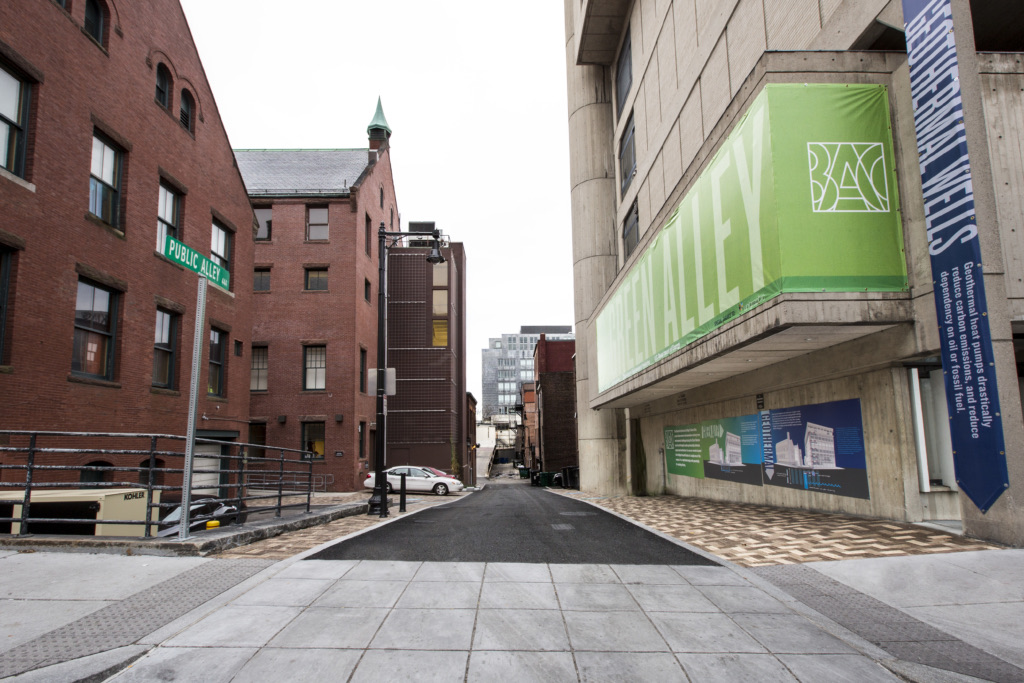
Boston Architectural College Green Alley
Boston Architectural College is located within Boston’s Back Bay neighborhood, meaning the problem of depleted ground water affects the campus directly. This project was developed to serve as a teaching tool as well as an opportunity to mitigate the groundwater problem and promote a more sustainable urban model for infrastructure.
The college sought to transform an underutilized alley into an attractive urban space, using green infrastructure to not only beautify the space but to capture stormwater from adjacent building roofs and alley surfaces, filter pollutants from stormwater, and maximize infiltration to supplement groundwater levels.
Halvorson | Tighe & Bond Studio led a multi-disciplinary design and engineering team to develop comprehensive plans for site sustainability improvements that would serve as a replicable model for the City of Boston and Back Bay.
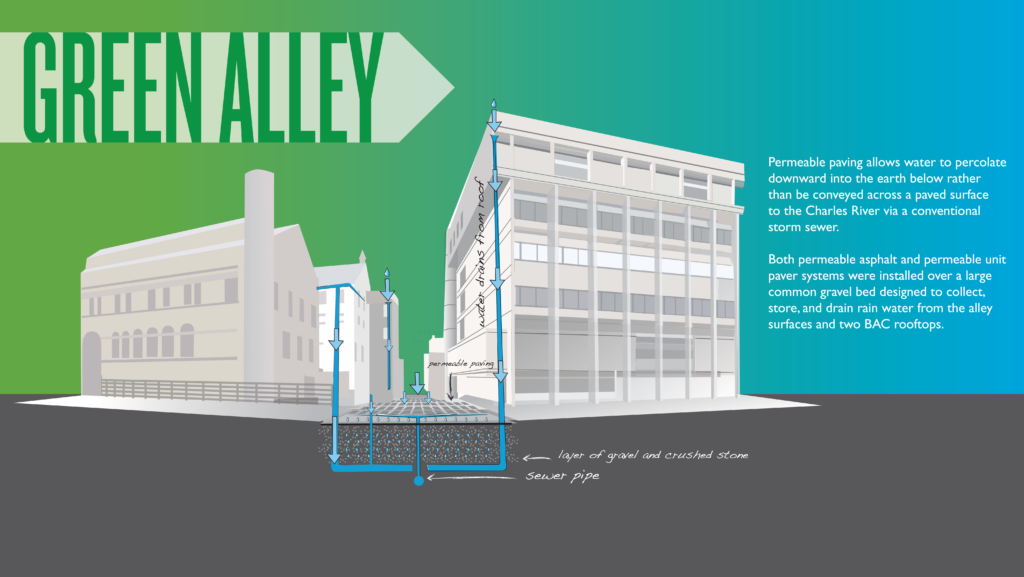
BAC Green Alley Diagram
The project also aims to engage students, constituencies and professional colleagues to examine energy use and define future design solutions through academic and applied learning scenarios together. Boston Architectural College launched a websitefor the project and incorporated interpretive graphics to inform and educate the public about the benefits of Green Alleys. They also invested in vine planting to provide visible “greening” of the alley, a transformation that makes the space more welcoming while at the same time helping to mitigate the heat island effect.
What was once an unsightly back alley of impervious asphalt paving has been transformed into an attractive front door for the campus that captures, treats and infiltrates storm water and recharges groundwater levels as well as integrates geothermal wells, which will provide efficient heating and cooling of campus buildings. Public Alley 444 incorporates permeable paving surfaces to redirect, collect, and infiltrate stormwater runoff from adjacent rooftops. Benefits include localized filtering of pollutants and infiltration of groundwater on site, which helps the depleted groundwater table of the Back Bay and significantly reduces the first flush stormwater pollutants from entering the Charles River.
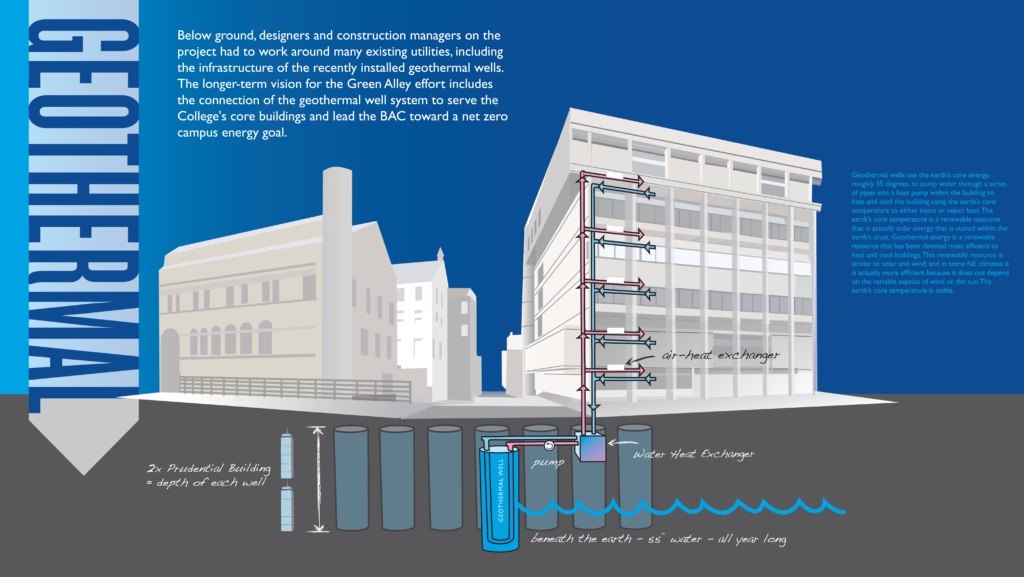
BAC Green Alley Diagram
BAC’s green alley is designed to accommodate 95% of storm events, redirecting more than 360,000 gallons of annual rainfall away from storm sewers and into providing much needed groundwater recharge. Integrated stormwater monitoring equipment allows the BAC to actively monitor the quantities of rainfall and storm water infiltration in real time, enabling the college to assess the ongoing effectiveness and actual benefits of the system.
What sets the Green Alley project apart from other institutional sustainable design initiatives is that this project was designed as a model for other urban institutions to emulate in order to create a more sustainable, green urban environment. It also represents a pioneering approach to permitting and collaboration with public entities. This project allowed for the first permitting of porous asphalt in a public way, the first permitting of geothermal wells in public way, and set policies for licensing and maintenance of green infrastructure.
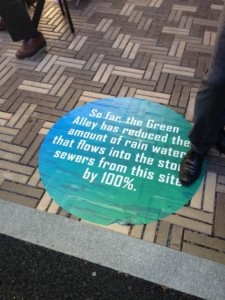
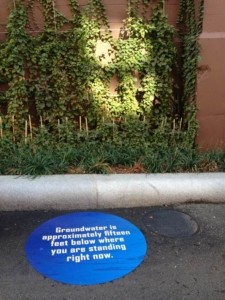
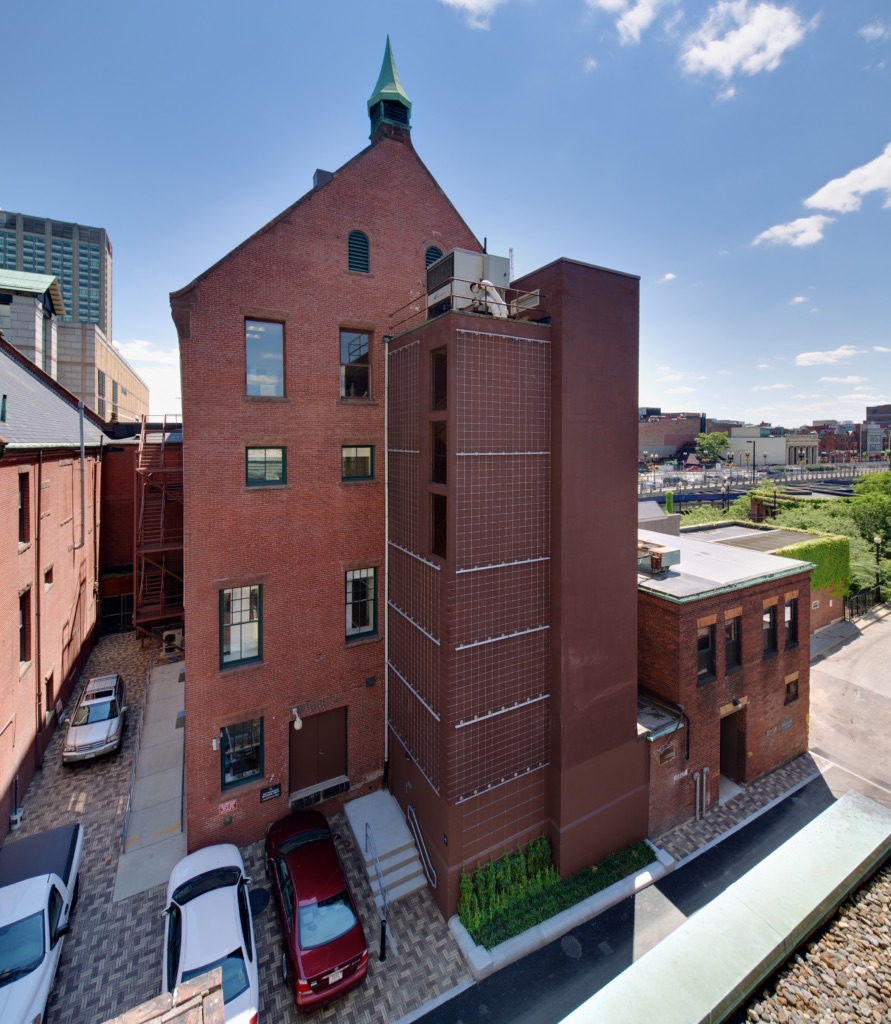
MBTA Government Center Plaza, Boston, MA
Solving issues of accessibility, sustainability, and placemaking, the new MBTA Government Center Station headhouse and plaza represents the first step in the revitalization of Boston’s City Hall Plaza. Working in collaboration with the City, MBTA, and various local agencies, HDR and Halvorson redesigned this portion of City Hall Plaza to introduce new gathering spaces and a variety of seating opportunities at different scales welcome visitors to soak up the sun or enjoy lunch at bistro tables under the dappled shade of large canopy trees.
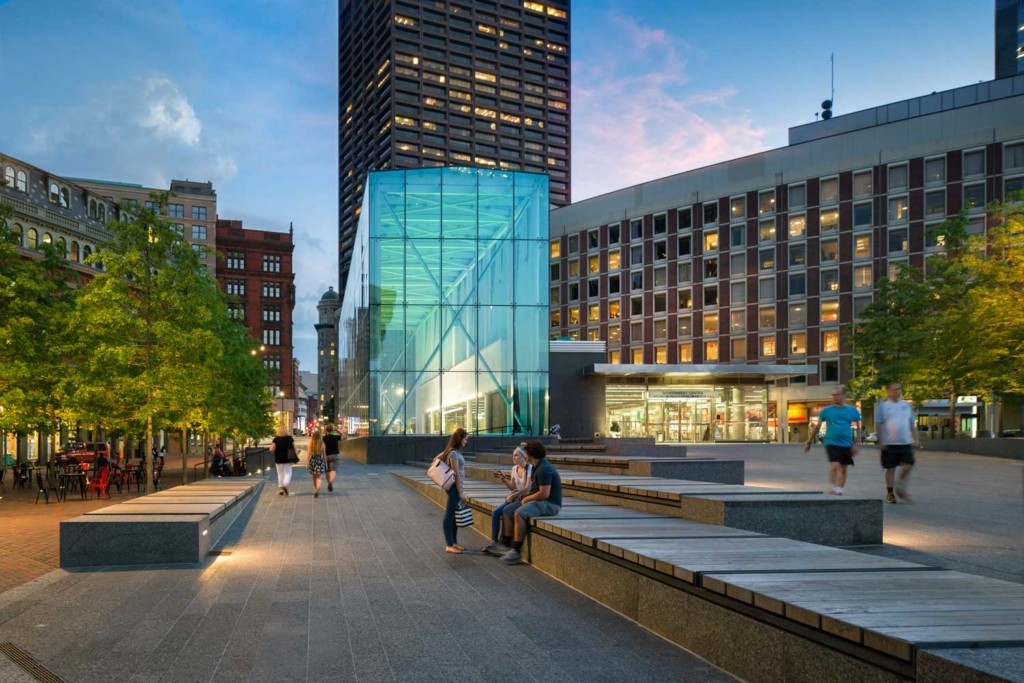
The redesigned plaza respects the existing Brutalist aesthetic while addressing the needs of 21st century pedestrians. New tree bosques help define the edges of the plaza, offering respite for residents, workers and tourists while providing environmental benefits that set the tone to achieve Boston’s goals for a resilient future. The tree bosques’ strong and defining presence aids in softening the expansive paved space while creating and enhancing opportunities for gathering around the headhouse and within the plaza itself. Activating the edges with green elements also draws people in and allows them to engage with the space at a human scale.
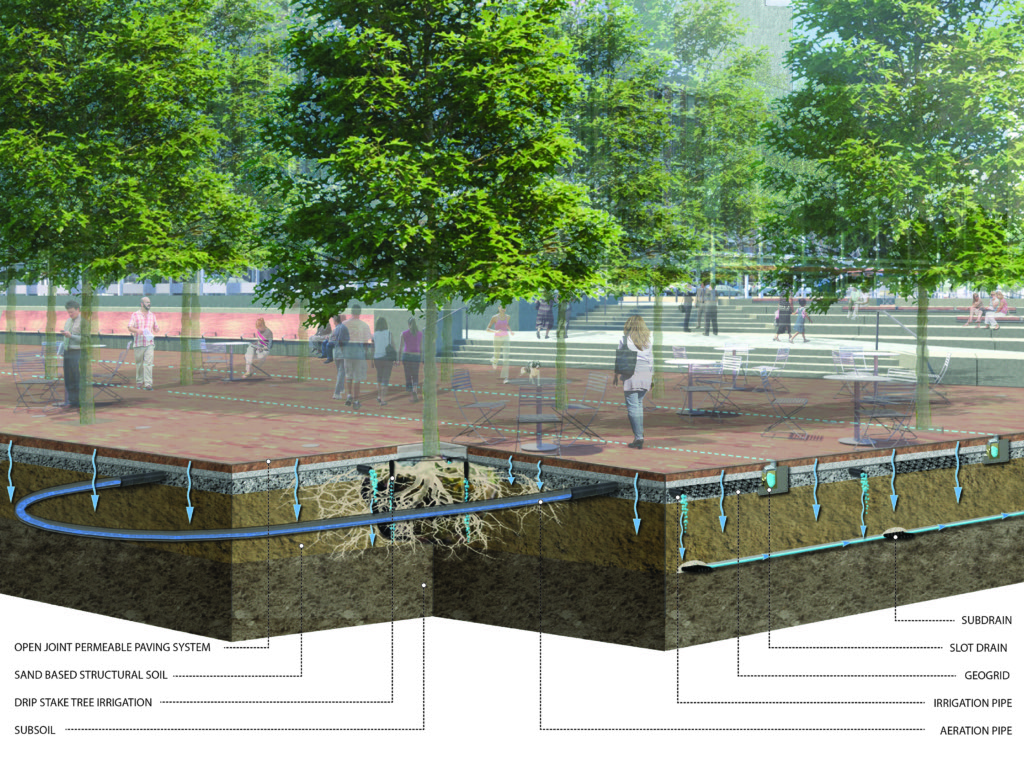
At a practical level, the introduction of 69 new trees reduces the heat island effect, making this portion of the plaza cooler in the summer and significantly more inviting. The trees are planted in an open-jointed permeable paving system, increasing their life expectancy while maximizing stormwater infiltration. Stormwater from the site and runoff from the headhouse is filtered through the permeable paving joints and slot drains into sand-based structural soils to support the trees.
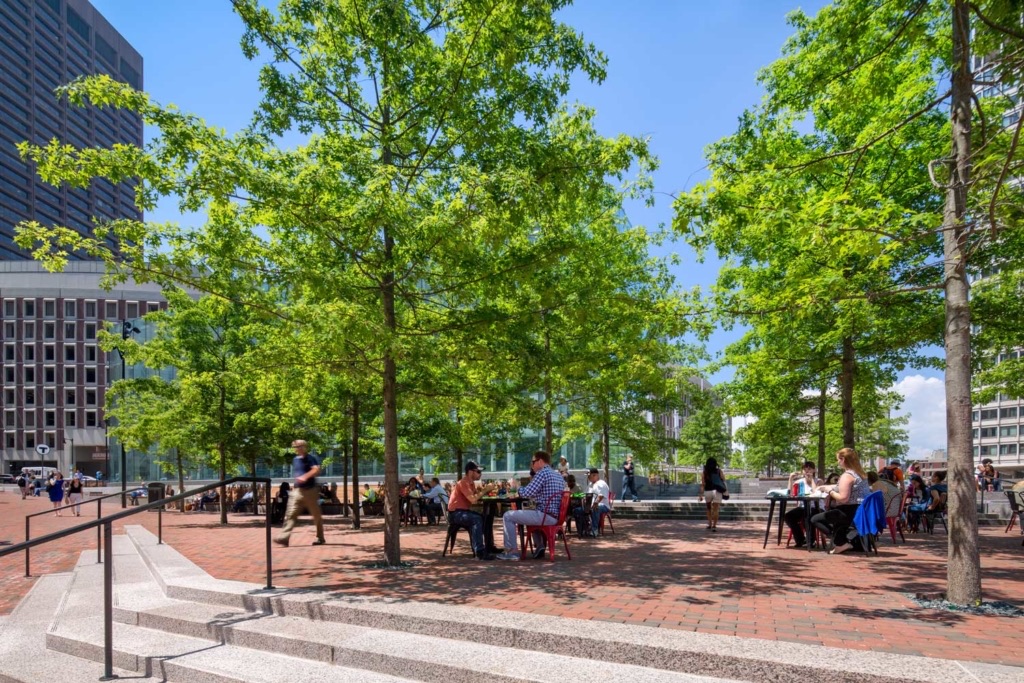
In addition to green infrastructure, the improvements have made Government Center Station a true multi-model transportation hub with improved pedestrian and bicycle access via the new headhouse, bike share stations, and electric vehicle charging stations. Most importantly, the existing terraced steps were replaced with sloped granite walks, providing universal access for the first time to Cambridge Street, the transit station, and City Hall.
The team successfully facilitated an intensive design process, resulting in a finished product that will complement future improvements to City Hall Plaza underway by Sasaki and navigates numerous site constraints, including accommodations for the plaza’s annual schedule of large-scale events and concerts, underground subway tunnels, building and utility infrastructure, emergency access, historically significant view sheds, and excessive grade changes.
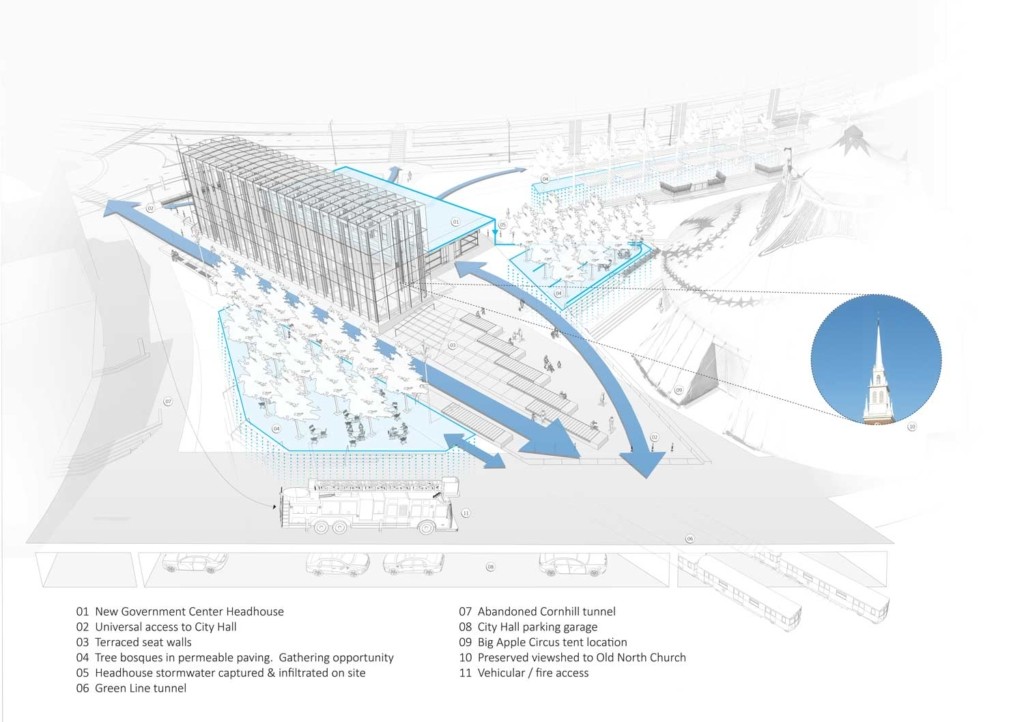
As the City of Boston’s first initiative through the Greening America’s Capitals program, the redesign transforms Government Center Plaza into an accessible, vibrant civic space. Rather than the “brick desert” of the past, the new headhouse and plaza redesign became the City’s first step in rebranding City Hall Plaza as Boston’s, “front lawn” where people are invited to gather, socialize, and engage with their civic leaders.
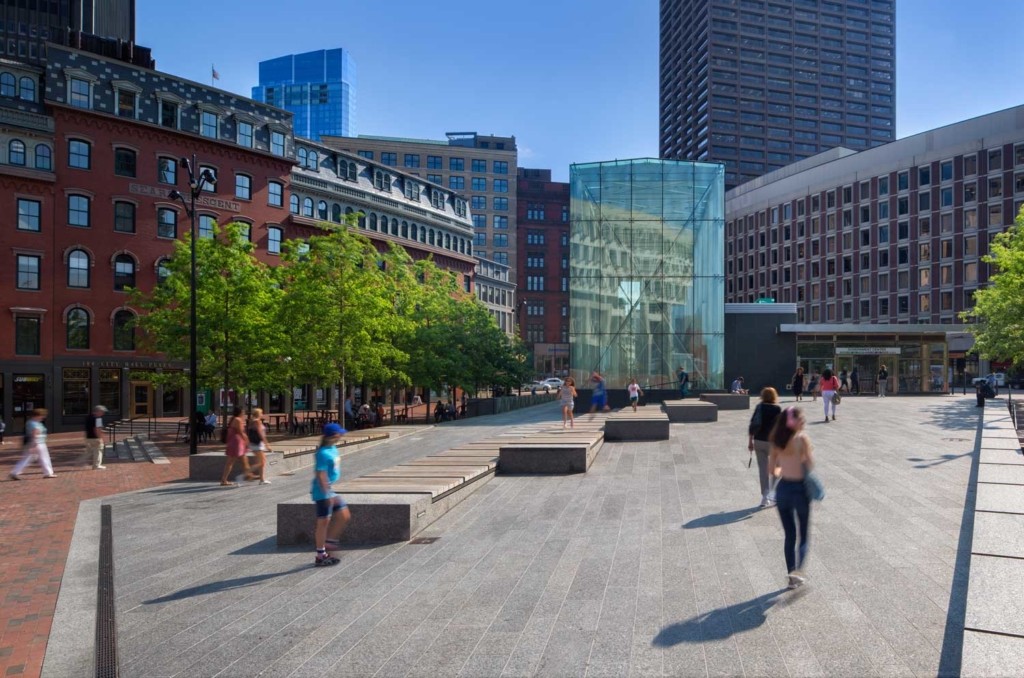
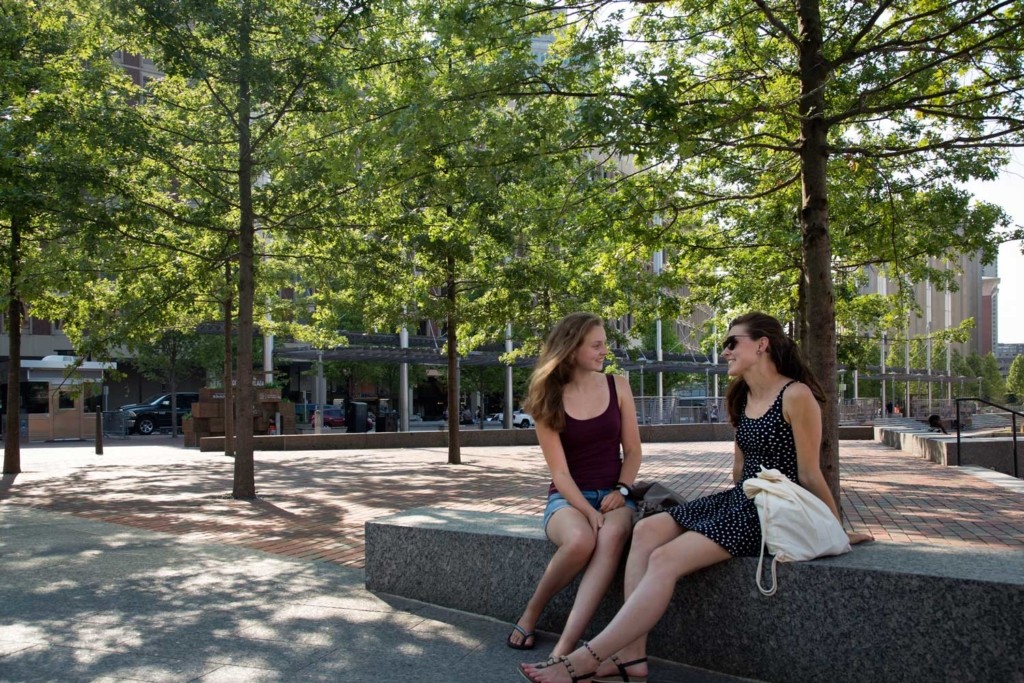
South Street Landing P3 Development, Providence, RI
South Street Landing is an ambitious P3 development in downtown Providence’s Jewelry district that creates a distinct new live/learn/work/play environment serving three of Rhode Island’s most prominent colleges and universities.
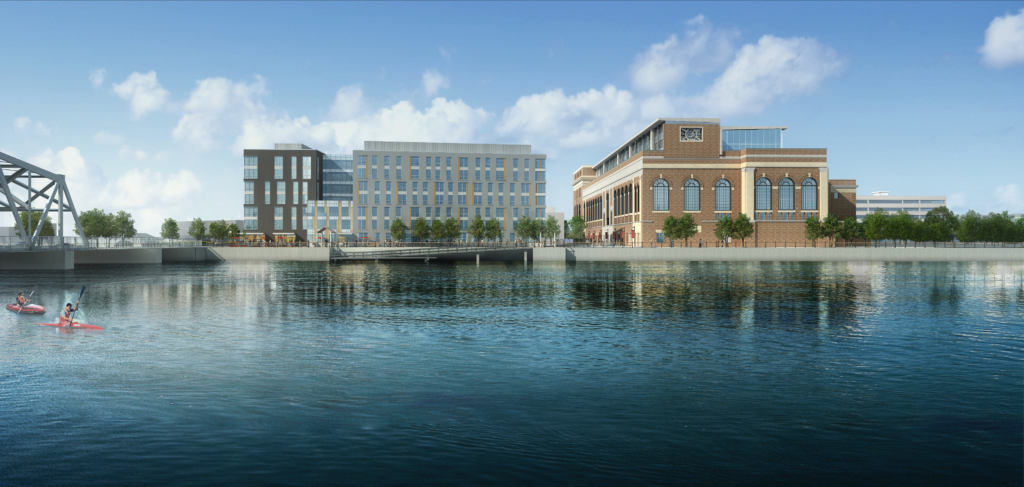
South Street Landing (SGA)
As part of a collaborative multi-disciplinary development team, Halvorson prepared a master plan and multi-phased design for transforming a group of underutilized industrial sites into an active, unified academic and residential environment with enhanced public access to and along the Providence River.
Halvorson’s design highlights the reuse of the prominent old Turbine House, which was adapted by architects Tsoi Kobus to create a new nursing school and administration space for Brown University, the University of Rhode Island, and Rhode Island College. The new River House designed by SGA features graduate student housing for Brown University.
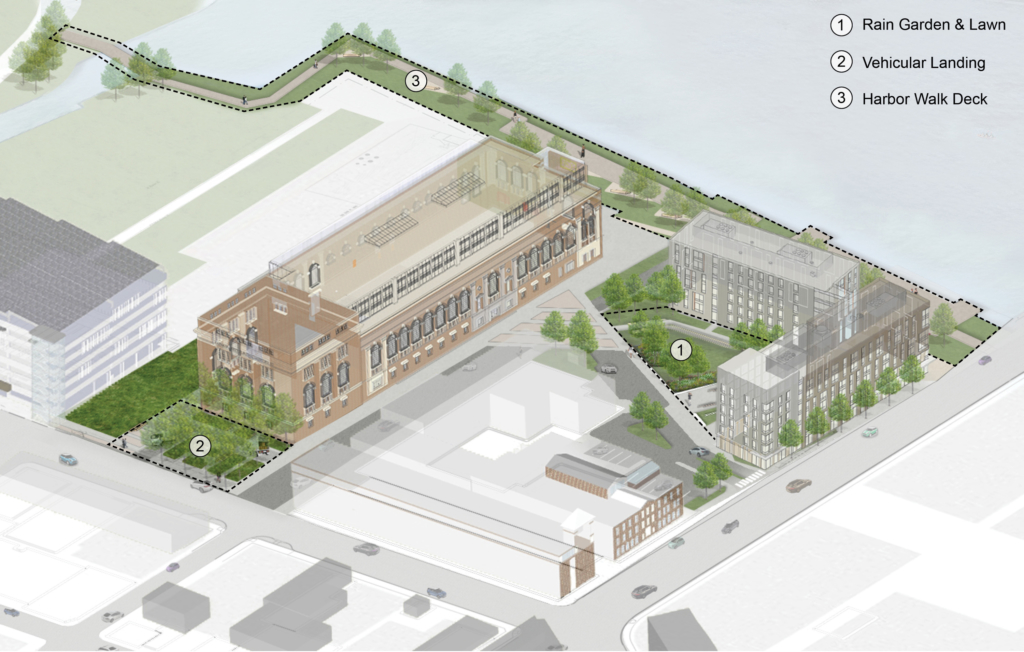
Given its proximity to the Providence River and location on a capped brownfield site, the project required close collaboration with local environmental groups (including the Rhode Island Department of Environmental Management and Rhode Island Coastal Resources Management Council) as well as a stormwater management system that uses permeable paving and on-site storage to prevent soil infiltration.
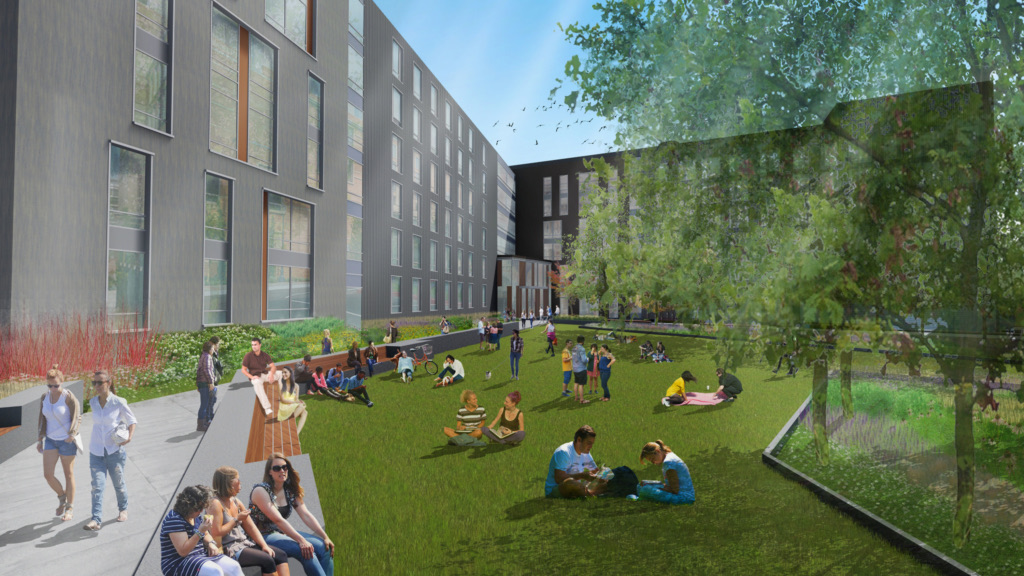
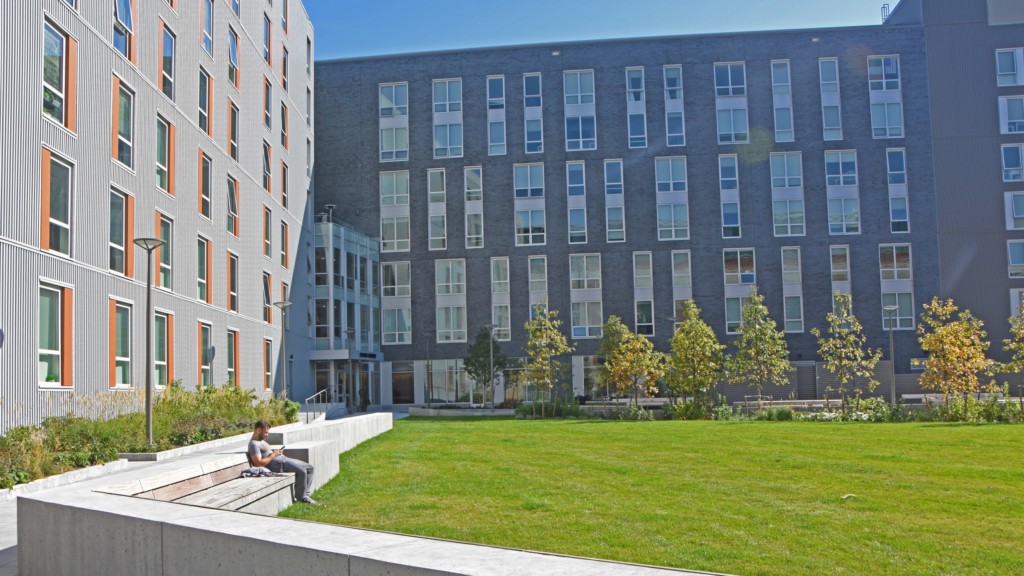
The site landscape is strategically designed to be floodable during significant rain events. The rain garden adjacent to the main walkway and the central lawn are topographically designed to accept rainwater and slowly release the stormwater into the drainage system and Providence River as storms subside.
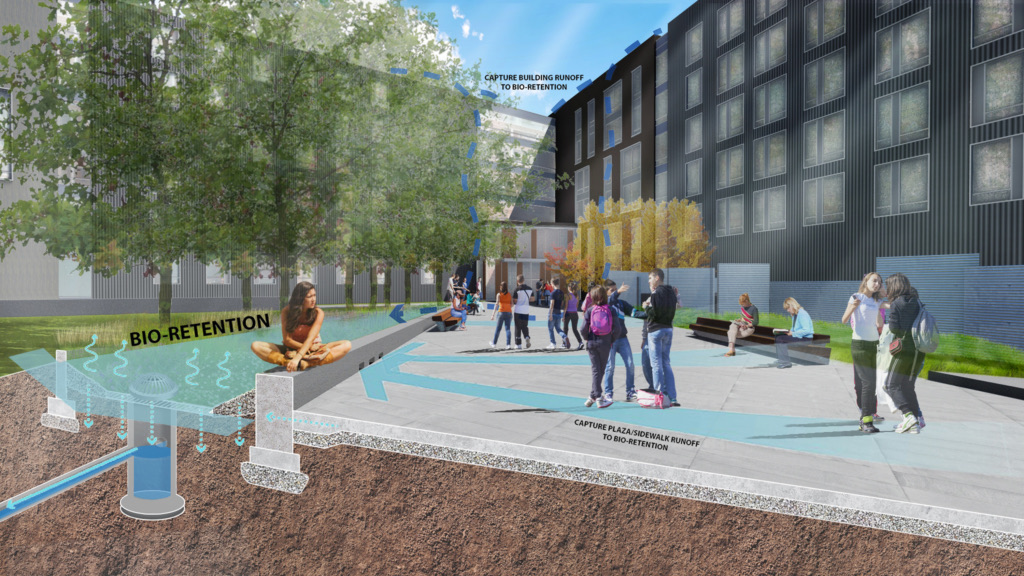
As part of the project, the design team worked with the Rhode Island Coastal Resources Management Council on the extension of the Providence Riverwalk. Our design for the greenway includes permeable paving and indigenous riverfront planting to create habitat and provide environmental enhancements to this previously industrial property. The Riverwalk will include gathering and socializing niches/overlooks of the Providence River for public use and will provide ADA-compliant public access connecting downtown Providence to the site via the Greenway and at Point Street. This part of the project has yet to be realized.
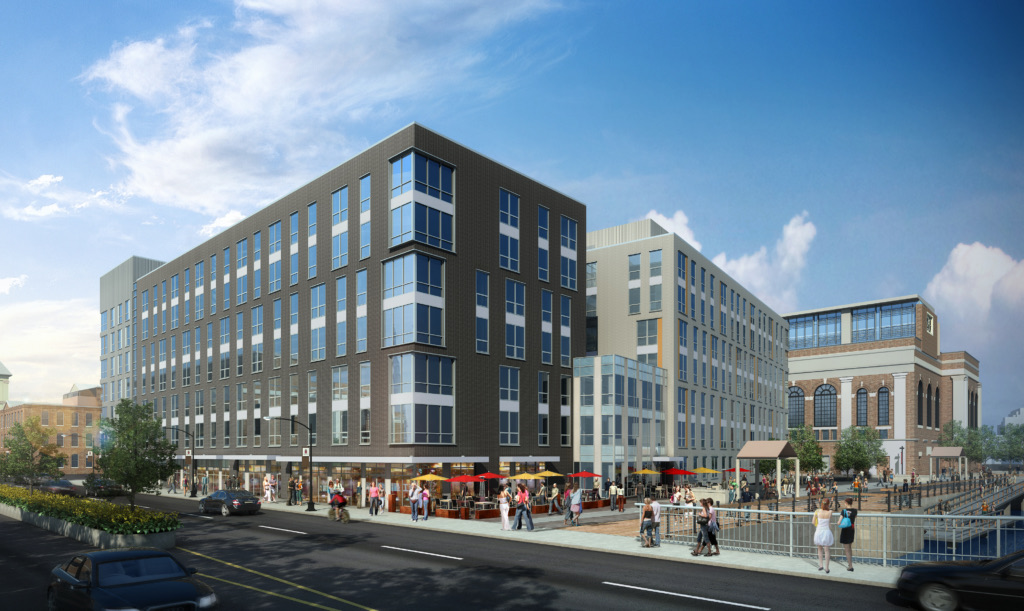
South Street Landing (Rendering by SGA)


